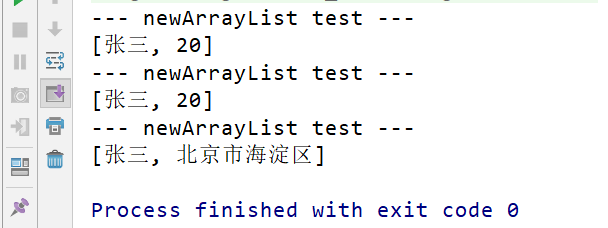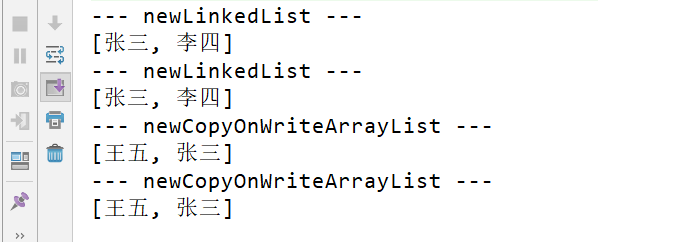Google guava
Guava is a supplement to the Java API. It implements the functions commonly used in java development more gracefully, making the coding easier and the code easier to understand. Guava uses a variety of design patterns and has undergone a lot of testing, which is favored by more and more development teams. The latest version of Java API adopts some functions of guava, but it is still irreplaceable.
characteristic
- Efficient and well-designed API is designed, implemented and used by Google developers
- Follow efficient java syntax practices
- Make the code more scale, concise and simple
- Save time, resources and improve productivity. Guava project contains several core libraries widely relied on by Google's Java project
Core library, for example:
- Collection [collections]
- caching
- Native type support [primitives support]
- concurrency libraries
- common annotations
- string processing
- I/O, etc.
github address
https://github.com/google/guava https://github.com/google/guava
https://github.com/google/guava
use
Dependency introduction
<dependencies>
<dependency>
<groupId>com.google.guava</groupId>
<artifactId>guava</artifactId>
<version>28.1-jre</version>
</dependency>
</dependencies>Guava collection utility class
Lists
Official website documents:
Lists (Guava: Google Core Libraries for Java 27.0.1-jre API) https://guava.dev/releases/27.0.1-jre/api/docs/com/google/common/collect/Lists.html Corresponding to the List set interface, on COM google. common. Under the collect package
https://guava.dev/releases/27.0.1-jre/api/docs/com/google/common/collect/Lists.html Corresponding to the List set interface, on COM google. common. Under the collect package
The Lists} interface is declared as follows:
@GwtCompatible(emulated=true)
public final class Lists
extends ObjectLists class mainly provides static methods for the construction and operation of subclasses of List class. In the lists class, the methods of constructing the # ArrayList, # LinkedList # and # newCopyOnWriteArrayList # objects are supported. The following functions for constructing ArrayList are provided: the following four functions construct an ArrayList object, but do not explicitly give the size of the application space:
newArrayList() newArrayList(E... elements) newArrayList(Iterable<? extends E> elements) newArrayList(Iterator<? extends E> elements)
Testing
ArrayList<Object> objects = Lists.newArrayList();
objects.add("Zhang San");
objects.add(20);
System.out.println("--- newArrayList test ---");
System.out.println(objects);
System.out.println("--- newArrayList test ---");
ArrayList<Object> objects1 = Lists.newArrayList(objects);
System.out.println(objects1);
System.out.println("--- newArrayList test ---");
ArrayList<String> strings = Lists.newArrayList("Zhang San", "Haidian District, Beijing");
System.out.println(strings);
The following two functions give the size of space to be allocated when constructing the ArrayList object:
newArrayListWithCapacity(int initialArraySize) newArrayListWithExpectedSize(int estimatedSize)
//If you know the number of elements in advance, you can use the newArrayListWithCapacity function; If you can't determine the number of elements, you can use the newArrayListWithExpectedSize function
//This method simply returns an array of 10.
ArrayList<Object> objects = Lists.newArrayListWithCapacity(10);
objects.add("123");
System.out.println(objects);
ArrayList<Object> objects1 = Lists.newArrayListWithExpectedSize(10);
objects1.add("123");
System.out.println(objects1);
In the # newArrayListWithExpectedSize # function, the # computeArrayListCapacity(int arraySize) function is called. Its implementation is as follows:
@VisibleForTesting
static int computeArrayListCapacity(int arraySize) {
checkArgument(arraySize >= 0);
// TODO(kevinb): Figure out the right behavior, and document it
return Ints.saturatedCast(5L + arraySize + (arraySize / 10));
}The returned capacity size is , 5L + arraySize + (arraySize / 10). When , arraySize , is relatively large, the ratio of the given size to the actual allocated capacity is 10 / 11.
The Lists # class also supports the construction of # LinkedList and newCopyOnWriteArrayList # objects. Its function interface is:
newLinkedList() newLinkedList(Iterable<? extends E> elements) newCopyOnWriteArrayList() newCopyOnWriteArrayList(Iterable<? extends E> elements)
/* newLinkedList()
newLinkedList(Iterable<? extends E> elements)
newCopyOnWriteArrayList()
newCopyOnWriteArrayList(Iterable<? extends E> elements) */
LinkedList<Object> objects = Lists.newLinkedList();
objects.add("Zhang San");
objects.add("Li Si");
System.out.println("--- newLinkedList ---");
System.out.println(objects);
ArrayList<Object> objects1 = Lists.newArrayList(objects);
System.out.println("--- newLinkedList ---");
System.out.println(objects1);
System.out.println("--- newCopyOnWriteArrayList ---");
CopyOnWriteArrayList<Object> objects2 = Lists.newCopyOnWriteArrayList();
objects2.add("Wang Wu");
objects2.add("Zhang San");
System.out.println(objects2);
System.out.println("--- newCopyOnWriteArrayList ---");
CopyOnWriteArrayList<Object> objects3 = Lists.newCopyOnWriteArrayList(objects2);
System.out.println(objects3);
We can also store two (or three) data of the same type in a list, which can be passed into functions with only one parameter or functions that need to reduce parameters. These functions are as follows:
asList(@Nullable E first, E[] rest) asList(@Nullable E first, @Nullable E second, E[] rest)
String str = "i love u";
String[] strs = {"i like u", "i miss u"};
List<String> strings = Lists.asList(str, strs);
System.out.println(strings);
The "transform" function in the "Lists" class can process "fromList" according to the "function" passed in, and store the processing results into a new list object, which is conducive to our analysis. The function interface is as follows:
public static <F, T> List<T> transform(List<F> fromList, Function<? super F, ? extends T> function)
Function<String, Integer> strlen = new Function<String, Integer>() {
public Integer apply(String from) {
Preconditions.checkNotNull(from);
return from.length();
}
};
List<String> from = Lists.newArrayList("abc", "defg", "hijkl");
List<Integer> to = Lists.transform(from, strlen);
for (int i = 0; i < from.size(); i++) {
System.out.printf("%s has length %d\n", from.get(i), to.get(i));
}
Maps
Official documents
Maps (Guava: Google Core Libraries for Java 27.0.1-jre API) https://guava.dev/releases/27.0.1-jre/api/docs/com/google/common/collect/Maps.html com. google. common. collect. Declaration of maps} interface:
https://guava.dev/releases/27.0.1-jre/api/docs/com/google/common/collect/Maps.html com. google. common. collect. Declaration of maps} interface:
@GwtCompatible(emulated=true)
public final class Maps
extends ObjectnewHashMap newHashMapWithExpectedSize newLinkedHashMap ImmutableMap difference transformValues
test
newHashMap
HashMap<Object, Object> hashMap = Maps.newHashMap();
for (int i = 0; i < 10; i++) {
hashMap.put(i, i);
}
System.out.println("hashMap: " + hashMap);
HashMap<Object, Object> hashMap1 = Maps.newHashMap(hashMap);
System.out.println("hashMap1: " + hashMap1);
newHashMapWithExpectedSize
Map<Integer, Integer> map = Maps.newHashMapWithExpectedSize(3);
map.put(1, 1);
map.put(2, 2);
map.put(3, 3);
System.out.println("map: " + map); // map: {1=1, 2=2, 3=3} 
newLinkedHashMap
Map<Integer, Integer> map = Maps.newLinkedHashMap();
map.put(11, 11);
System.out.println("map: " + map);
LinkedHashMap<Integer, Integer> map1 = Maps.newLinkedHashMap(map);
System.out.println("map1: " + map1);
ImmutableMap
ImmutableMap<String, String> a = ImmutableMap.of("a", "1");
System.out.println(a); 
difference
Map<Integer, Integer> map = Maps.newHashMap();
map.put(10, 10);
Map<Integer, Integer> map1 = Maps.newHashMap();
map1.put(10, 10);
map1.put(20, 20);
MapDifference<Integer, Integer> difference = Maps.difference(map, map1);
System.out.println(difference.areEqual());
System.out.println(difference.entriesInCommon());
System.out.println(difference.entriesOnlyOnRight());
System.out.println(difference.entriesOnlyOnLeft());
System.out.println(difference.entriesDiffering());
System.out.println(difference);transformValues
Map<String, Boolean> fromMap = Maps.newHashMap();
fromMap.put("key", true);
fromMap.put("value", false);
// Negate the incoming element
System.out.println(Maps.transformValues(fromMap, (Function<Boolean, Object>) input -> !input));
// If value is false, key will be capitalized
Maps.EntryTransformer<String, Boolean, String> entryTransformer = (key, value) -> value ? key : key.toUpperCase();
System.out.println(Maps.transformEntries(fromMap, entryTransformer));Sets
Official documents
Sets (Guava: Google Core Libraries for Java 27.0.1-jre API) https://guava.dev/releases/27.0.1-jre/api/docs/com/google/common/collect/Sets.html com. google. common. collect. Declaration of sets} interface:
https://guava.dev/releases/27.0.1-jre/api/docs/com/google/common/collect/Sets.html com. google. common. collect. Declaration of sets} interface:
@GwtCompatible(emulated=true)
public final class Sets
extends ObjectnewHashSet filter difference symmetricDifference intersection union cartesianProduct powerSet
newHashSet
HashSet<Object> objects = Sets.newHashSet();
objects.add("Zhang San");
objects.add("Li Si");
System.out.println(objects); 
filter
/**
* filter: Returns the element Set that satisfies the given Predicate in the incoming Set unfiltered
*/
@Test
public void testFilter() {
Set<String> set = Sets.newHashSet("i like u", "i miss u", "i love u");
Predicate<String> predicate = new Predicate<String>() {
@Override
public boolean apply(String input) {
//Filter elements that contain the letter l
return input.contains("l");
}
};
System.out.println(Sets.filter(set, predicate)); // [i like u, i love u]
System.out.println(Sets.filter(set, input -> input.contains("l"))); // [i like u, i love u]
}
difference
/**
* difference: Non modifiable SetView that returns the difference between two sets
* A,B If there are two sets, the set composed of all elements belonging to A and not belonging to B is called the difference set of A and B
*/
@Test
public void testDifference() {
Set<Integer> set1 = Sets.newHashSet(1, 2, 3, 4, 5);
Set<Integer> set2 = Sets.newHashSet(1, 3, 5, 7, 9);
System.out.println(Sets.difference(set1, set2)); // [2, 4]
} 
symmetricDifference
/**
* symmetricDifference: An unmodifiable SetView that returns the symmetry difference between two sets
* Symmetry difference, that is, the symmetry difference between two sets, is a set composed of elements belonging to only one set and not to the other set
*/
@Test
public void testSymmetricDifference() {
Set<Integer> set1 = Sets.newHashSet(1, 2, 3, 4, 5);
Set<Integer> set2 = Sets.newHashSet(1, 3, 5, 7, 9);
System.out.println(Sets.symmetricDifference(set1, set2)); // [2, 4, 9, 7]
} 
intersection
/**
* intersection: Returns a non modifiable SetView of the intersection of two set sets
* The intersection of two sets A and B refers to A set containing all elements belonging to both A and B without other elements
*/
@Test
public void testIntersection() {
Set<Integer> set1 = Sets.newHashSet(1, 2, 3, 4, 5);
Set<Integer> set2 = Sets.newHashSet(1, 3, 5, 7, 9);
System.out.println(Sets.intersection(set1, set2)); // [1, 3, 5]
}
Union
/**
* Union: Returns a non modifiable SetView of the union of two sets
* If A and B are sets, the union of A and B is A set with all elements of A and all elements of B, but no other elements
*/
@Test
public void testUnion() {
Set<Integer> set1 = Sets.newHashSet(1, 2, 3, 4, 5);
Set<Integer> set2 = Sets.newHashSet(1, 3, 5, 7, 9);
System.out.println(Sets.union(set1, set2)); // [1, 2, 3, 4, 5, 9, 7]
}
cartesianProduct
/**
* cartesianProduct: Returns each possible set formed by selecting an element from each given set
*/
@Test
public void testCartesianProduct() {
Set<String> set1 = Sets.newHashSet("i love u", "i hate u");
Set<String> set2 = Sets.newHashSet("tom", "jerry");
Set<List<String>> sets = Sets.cartesianProduct(set1, set2);
System.out.println(sets); // [[i hate u, tom], [i hate u, jerry], [i love u, tom], [i love u, jerry]]
}
powerSet
/**
* powerSet: Returns a set containing all possible parent sets of a given set
*/
@Test
public void testPowerSet() {
Set<String> set1 = Sets.newHashSet("A", "B", "C");
Set<Set<String>> sets = Sets.powerSet(set1);
// for (Set<String> set : sets) {
// System.out.println(set);
// }
System.out.println(Arrays.toString(sets.toArray())); // [[], [A], [B], [A, B], [C], [A, C], [B, C], [A, B, C]]
}
Complete code
Unit testing with junit in maven project
import com.google.common.base.Predicate;
import com.google.common.collect.Sets;
import org.junit.Test;
import java.util.Arrays;
import java.util.List;
import java.util.Set;
public class TestSets {
/**
* filter: Returns the element Set that satisfies the given Predicate in the incoming Set unfiltered
*/
@Test
public void testFilter() {
Set<String> set = Sets.newHashSet("i like u", "i miss u", "i love u");
Predicate<String> predicate = new Predicate<String>() {
@Override
public boolean apply(String input) {
//Filter elements that contain the letter l
return input.contains("l");
}
};
System.out.println(Sets.filter(set, predicate)); // [i like u, i love u]
System.out.println(Sets.filter(set, input -> input.contains("l"))); // [i like u, i love u]
}
/**
* difference: Non modifiable SetView that returns the difference between two sets
* A,B If there are two sets, the set composed of all elements belonging to A and not belonging to B is called the difference set of A and B
*/
@Test
public void testDifference() {
Set<Integer> set1 = Sets.newHashSet(1, 2, 3, 4, 5);
Set<Integer> set2 = Sets.newHashSet(1, 3, 5, 7, 9);
System.out.println(Sets.difference(set1, set2)); // [2, 4]
}
/**
* symmetricDifference: An unmodifiable SetView that returns the symmetry difference between two sets
* Symmetry difference, that is, the symmetry difference between two sets, is a set composed of elements belonging to only one set and not to the other set
*/
@Test
public void testSymmetricDifference() {
Set<Integer> set1 = Sets.newHashSet(1, 2, 3, 4, 5);
Set<Integer> set2 = Sets.newHashSet(1, 3, 5, 7, 9);
System.out.println(Sets.symmetricDifference(set1, set2)); // [2, 4, 9, 7]
}
/**
* intersection: Returns a non modifiable SetView of the intersection of two set sets
* The intersection of two sets A and B refers to A set containing all elements belonging to both A and B without other elements
*/
@Test
public void testIntersection() {
Set<Integer> set1 = Sets.newHashSet(1, 2, 3, 4, 5);
Set<Integer> set2 = Sets.newHashSet(1, 3, 5, 7, 9);
System.out.println(Sets.intersection(set1, set2)); // [1, 3, 5]
}
/**
* Union: Returns a non modifiable SetView of the union of two sets
* If A and B are sets, the union of A and B is A set with all elements of A and all elements of B, but no other elements
*/
@Test
public void testUnion() {
Set<Integer> set1 = Sets.newHashSet(1, 2, 3, 4, 5);
Set<Integer> set2 = Sets.newHashSet(1, 3, 5, 7, 9);
System.out.println(Sets.union(set1, set2)); // [1, 2, 3, 4, 5, 9, 7]
}
/**
* cartesianProduct: Returns each possible set formed by selecting an element from each given set
*/
@Test
public void testCartesianProduct() {
Set<String> set1 = Sets.newHashSet("i love u", "i hate u");
Set<String> set2 = Sets.newHashSet("tom", "jerry");
Set<List<String>> sets = Sets.cartesianProduct(set1, set2);
System.out.println(sets); // [[i hate u, tom], [i hate u, jerry], [i love u, tom], [i love u, jerry]]
}
/**
* powerSet: Returns a set containing all possible parent sets of a given set
*/
@Test
public void testPowerSet() {
Set<String> set1 = Sets.newHashSet("A", "B", "C");
Set<Set<String>> sets = Sets.powerSet(set1);
// for (Set<String> set : sets) {
// System.out.println(set);
// }
System.out.println(Arrays.toString(sets.toArray())); // [[], [A], [B], [A, B], [C], [A, C], [B, C], [A, B, C]]
}
}